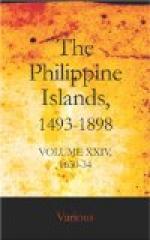the Spaniards might defend themselves, and if possible,
drive the enemy from the islands. Although diligent
efforts were made in this, when our fleet set sail
already had the enemy rounded the island of Panay.
Our fleet, which consisted of seven caracoas and four
or five barangays, followed the enemy. They reached
the islets of Asur, where they heard that the enemy
had passed there, with the intention of burning the
city of Arevalo and the village of Octong, with all
their provisions. The captain and commander of
our fleet was Captain Salgado, then alcalde-mayor
of Sugbu. The two fleets met near Pan de Azucar
[
i.e., “Sugar Loaf"]. The Spaniards
were very resolute. The enemy formed themselves
in a crescent with sixty caracoas. So senseless
were they that they untied their captives, threw them
overboard, and came to attack our boats. I know
not the captain’s design or purpose, that made
him dally with the enemy, so that the latter were shouting
out spiritedly and imagining that they were feared.
The father provincial and his companion, Fray Hernando
Guerrero, [5] talked encouragingly to the petty leaders,
and encouraged and even shamed them so much that,
already late, they gave the signal to attack.
Thereupon, the enemy sought shelter, and after steering
their caracoas to where they thought that they had
more safety, they divided. The captain did not
pursue them nor do more than to go to Arevalo.
On that account he lost a good opportunity and much
credit. He should have continued to pursue them;
for, when night fell, the caracoas of the frightened
enemy remained along those coasts. The commander
could easily have overhauled them with our caracoas,
and could have given the enemy a blow that would have
done much to finish them; but he failed to do so.
The efforts that he finally put forth, and the attack,
are owing to the resolution and bravery of our father
Fray Pedro de Arce, in which one may consider his
desire for the common good. For, although he
might have sent other religious, he went in person,
and put no value on his own life. [6] He returned
to Manila, where he finished his term, creating the
desire in the fathers to see him provincial forever.
In the chapter that elected our father Montesdoza,
procurators were sent to Espana and to the Roman court.
The papers and title of definitor of the chapter were
given to our father Fray Lorenzo de Leon, who has
just finished his provincialate. He embarked at
the port of Cavite, made the trip to Nueva Espana
safely, and likewise to the court of King Felipe III,
of blessed memory. He did not go to Roma, but
sent his papers from Espana. He was very well
received at court, for the papers that he carried
from the islands were excellent, and in his person
he merited everything. They were very desirous
to appoint him archbishop of Manila, and it is even
said that they begged him to accept rewards, and congratulated
him. But that shadow was dissipated instantly,
as there was not wanting an evil-minded person to spoil




